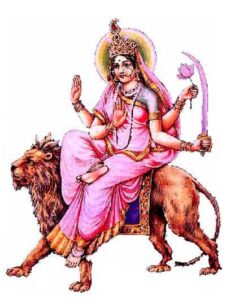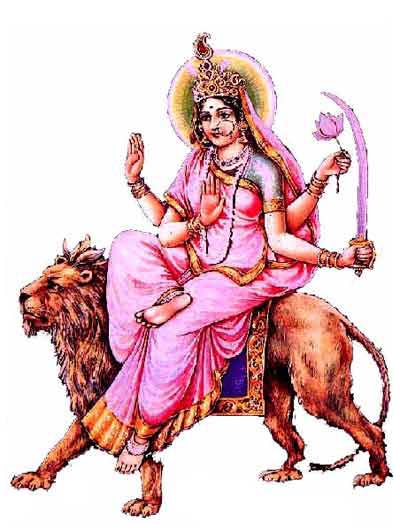
The sixth day of Navarathri is given over to Goddess Katyayani. She is called Katyayani because she was born as the daughter of Sage Katya of Katya clan. The colour of the day is Yellow. We have supplied a light green background to enable easy reading sans glare.
Bhagavad Gita 10:34 … Of the qualities that, due to their grace and tenderness, are termed ‘female’, I am fame and fortune, sweet speech, memory, intelligence, steadfast perseverance, loyalty, and forgiveness.
To make up the nine nights, we will add repositories of truth and culture to the list given from the Bhagavad Gita.
Goddess of Day 6: Katyayani
Day 6 is dedicated to goddess Katyayani. According to the scriptures, goddess Parvati took the form of Katyayani to destroy Mahishasura, who was a demon. And, Katyayani was the most violent form of goddess Parvati. This form of Maa Parvati is also known as warrior goddess.
She is worshipped as the Warrior Goddess, being the fiercest form of Goddess Durga, she is referred to as Bhadrakali, Shakti, and Chandika too. Katyayani is the symbol of shakti, knowledge, courage and those who revere her are blessed with these qualities. Devi Kanyakumari is an incarnation of Devi Katyayani. She is worshipped during the harvest festival of Tamil Nadu, Pongal for abundance, rain, and prosperity. The word Katyayani symbolizes the destruction of negativities and ego. Her devotees are rewarded with a pure and clean heart. Young marriageable girls in Gokula prayed to this Goddess and observed fast during the holy month of Mrgashirsha to be blessed with loving and worthy husbands.
Stuti:
Ya Devi Sarvabhuteshu Maa Katyayani Rupena Samsthita
Namastasyai Namastasyai Namastasyai Namo Namaha
The Teachings of the Mother and The Importance of Speaking Truth
The teachings of mother play a vital role in shaping the future of her children. She should make every effort to drive away bad qualities from her children and infuse human values like sathya, dharma, shanthi, prema, and ahimsa (truth, righteousness, peace, love, and nonviolence) in them. There are many who give speeches at length about the importance of these values in our daily life, but how many are translating them into action? Very few. They do not utter truth nor do they perform righteous deeds. Our ancients never deviated from the path of truth and righteousness under any circumstances. Sathyannasti paro dharma (There is no dharma greater than adherence to truth). The Vedas teach, Sathyam vada, dharmam chara (speak truth, practice righteousness). Your thoughts, words, and deeds should be in harmony with each other. It is said, “The proper study of mankind is man.” Today, nobody knows what man has in his mind because his thoughts, words, and deeds are in total variance. He is wasting his life with such unethical behaviour.
The tongue is given to speak truth.
You are very sacred.
Speak the truth in the most pleasing manner.
Chant the divine names of Govinda, Madhava and Damodara incessantly.
This is your foremost duty.
The tongue, which is meant to utter sacred words, is being used to criticise others. One cannot describe in words the fate of such a person. Our ancients had so much love for their motherland that they wanted to be born again and again in this sacred land of Bharat. But today people have neither love for the country) nor love for righteousness. Instead, they are developing love for the body. Your body is like a water bubble. How long can you protect it? It will burst sooner or later. Hence, develop love for the Atma, which alone can protect the entire world. Develop faith that the same Atma exists in you and all others. When you have such strong faith, the whole nation would prosper. One with love for the Atma is a true human being. If one does not have love for the Divine Atma, if one does not seek the Divine Atma within and without, one’s life is wasted.

She it is who puts the prayers in my mouth,
and she to whom I speak them.
They come from her, arise in me,
and return again to her,
so that my praying is a part of her eternal cycle;
and when I pray, it is her words I pray;
and when I sing, it is her song;
and when I act, it is her deeds I do.
I cannot step outside the way she has laid out,
for there is nowhere outside to step.
Ground of being, you contain all within you,
both that which acts and that which is acted upon.
Nowhere is there anything that does not arise in you.
Nothing is there that does not praise you by its existence.
108 Names of the Divine Mother (English)
Om… I bow to SHE who is the Mother of the Universe.
Each of the Divine Names (in English) ends with ~ swaha.
When you use the Sanskrit word swaha you are invoking the God / Goddess, you are arousing the God / Goddess to come and witness your action, to come and receive your prayer.
We append these 108 Names of the Divine Mother and pray that you will be understanding the significance of the prayers, along with the efficacy of same.
Download the 108 Names of the Divine Mother

It is said that each day has a colour, and that idols of the Gods worshipped on these days are clothed in sari and other clothing in the colours given. Several sources give several colours. We will be following the day colours as given by Drik Panchang, which may vary from other sources. It is not our intention to cause offence with colours given.
![]()

